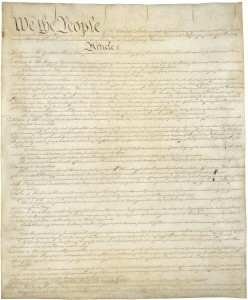WE, THE CITIZENS OF MARYLAND, TRUSTING IN GOD, THE SUPREME RULER OF THE UNIVERSE, PLEDGE FAITH IN OUR BROTHERS WHO GAVE THEIR ALL IN THE WORLD WAR TO MAKE THE WORLD SAFE FOR DEMOCRACY. THEIR MORTAL BODIES HAVE TURNED TO DUST. BUT THEIR SPIRIT LIVES TO GUIDE US THROUGH LIFE IN THE WAY OF GODLINESS, JUSTICE, AND LIBERTY.
WITH OUR MOTTO, “ONE GOD, ONE COUNTRY AND ONE FLAG,” WE CONTRIBUTE TO THIS MEMORIAL CROSS COMMEMORATING THE MEMORY OF THOSE WHO HAVE NOT DIED IN VAIN.
By: Robert Tucci
On Wednesday, October 18, 2017, the Fourth Circuit issued a published opinion in American Humanist Association v. Maryland-National Capital Park & Planning Commission. Several residents of Prince George’s County, Maryland, along with the American Humanist Association (“AHA”) – a non-profit organization dedicated to upholding the founding principle of separation of church and state – brought suit against a Maryland government agency, claiming that the government’s maintenance of a 40-foot tall World War I Latin Cross monument violated the Establishment Clause. The district court granted summary judgment for the government, and the plaintiffs appealed. The Fourth Circuit reversed and remanded the decision of the lower court, finding that the Cross violated the second and third prongs of the Lemon test.
Facts and Procedural History
On September 28, 1919, several private organizers held a groundbreaking ceremony on land owned by the city of Bladensburg, Maryland, to begin erecting a giant 40-foot Latin Cross memorial. The Cross was built next to a pre-existing plaque which was placed to honor 49 World War I United States soldiers. To fund the construction of the Cross, the private organizers obtained funding from private donors. The donors were required to sign a pledge sheet, which recognized the existence of “one god” (text of pledge sheet above).
The private organizers ran out of money in 1922 to continue funding the project. As a result, a local post of the American Legion stepped in to continue fundraising and construction of the Cross. Several of the Legion’s fundraising and memorial services concerning the Cross, both before and after construction was completed, contained exclusively sectarian Christian activities. Such activities included prayers at invocations and benedictions, Sunday worship service, speaker-led prayers, and singing Christian hymns. The Legion completed construction in 1925, and placed the four-story tall Latin Cross in the median of a three-way highway intersection in Bladensburg.
On March 1, 1961, the Maryland-National Capital Park and Planning Commission (“Commission”), a Maryland government agency, obtained title to the Cross and the land beneath it. The Commission claimed it acquired the Cross for safety reasons due to the proximity of the Cross to a busy highway. Since 1961, the Commission has spent $117,000 to maintain and repair the Cross, with an additional $100,000 set aside in 2008 for future repairs.
The Cross is part of the Bladensburg Veterans Memorial Park. All other monuments in the park are ten feet tall or shorter, devoid of religious iconography, and located at least 200 feet from the Cross. The Legion’s symbol (a small star inscribed with “U.S.”) is attached near the top of the Cross, and an American flag resides near the Cross. The plaque honoring the 49 soldiers sits on an obscured corner on the Cross’s rectangular base, and has been weathered to the point of being illegible.
The AHA and several non-Christian residents of Prince George’s County, who faced multiple instances of unwelcome contact with the Cross while driving, filed suit against the Commission, claiming that the Cross amounts to government affiliation with Christianity. The AHA and residents sought a declaratory judgment that the Commission’s conduct violates the Establishment Clause and the plaintiffs’ constitutional rights, an injunction enjoining the Commission from displaying the Cross on public property, nominal damages, and attorney’s fees and costs.
Both sides filed cross-motions for summary judgment, with the district court granting summary judgment to the Commission. The district court found that the Commission and Cross satisfied the three prong test set out in Lemon v. Kurtzman. The plaintiffs subsequently appealed to the Fourth Circuit.
Do Plaintiffs Have Standing to Sue?
The Court first analyzed the Commission’s argument that the plaintiffs lack standing to bring suit. The Commission contended that the plaintiffs had not “forgone any legal rights” as a result of the Commission’s conduct. The Court rejected this argument, stating that “[a]n Establishment Clause claim is justiciable even when plaintiffs claim noneconomic or intangible injury.” Specifically, the Court found that the non-AHA plaintiffs have standing due to their alleged unwelcome direct contact with the Cross, and that the AHA has standing to sue because an association can sue on behalf of its members if the members would also have standing to sue on their own.
Does Van Orden Control?
The Court then turned to the Commission’s argument that the holding in Van Orden v. Perry, rather than the Lemon test, should control. Van Orden dealt with a similar issue of whether a monument displaying the Ten Commandments on government property violated the Establishment Clause. The Court acknowledged that the plurality opinion in Van Orden is favorable to the Commission, but declined to follow it due to Justice Breyer’s controlling (and limiting) concurrence.
In his concurrence, Justice Breyer lays out several non-exhaustive factors for evaluating monuments eliciting both a secular and non-secular purpose, including: (1) the circumstances surrounding the monument’s placement; (2) its physical setting; and (3) the length of time it remains unchallenged. However, the Court noted that Justice Breyer reaffirmed Lemon by saying that it is a “useful guidepost[],” and remains a “more formal Establishment Clause test[].” Thus, the Court chose to apply the Lemon test, while giving due consideration to the Van Orden factors.
Does the Bladensburg Cross Satisfy the Lemon Test?
Next, the Court analyzed whether the Bladensburg Cross is constitutional under the Lemon test. A government display is constitutional under the Lemon test if it satisfies three prongs: (1) the display has a secular purpose; (2) the display does not have a “principle or primary effect” that advances, inhibits, or endorses religion; and (3) the display does not foster “an excessive entanglement between government and religion.” If the display violates even one prong, it is unconstitutional.
Secular Purpose
The Court held that the Cross satisfied the first prong of the Lemon test. The Court acknowledged that it is a fairly low burden to establish a secular purpose for a government display, because even if the display has “dual legitimate purposes” (one secular and one sectarian), it still satisfies the first prong of the Lemon test. The Commission articulated several secular reasons for displaying and maintaining the Cross, including ensuring safety near a busy highway, and the preservation of a significant war memorial. The Court found these to be legitimate secular reasons, thus finding that the Cross satisfied the first prong of the Lemon test.
Primary Effect
Next, the Court held the Cross violated the second prong of the Lemon test. The Court found the relevant question under the second prong to be “does the practice under review in fact convey a message of endorsement or disapproval of religion?” The Court stated that this question must be answered from the perspective of a “reasonable observer” – someone who “must be deemed aware of the history and context of the community and forum in which the religious speech takes place.” Therefore, the Court found that a detailed factual analysis of the Cross’ meaning, history, and secularizing elements was required to determine its primary effect.
Under the “meaning” inquiry, the Court concluded that the Latin cross is the “preeminent symbol of Christianity,” one that is not a symbol of any other religion. The court went on to say that even the Latin cross’ supposed secular symbology of death and memorialization is tied to the Christian sectarian teaching of Jesus Christ’s death and resurrection. Further, the Court found the Latin cross differed from other religious monuments, like the Ten Commandments, as it is not tied to the United States’ history and government.
Turning to the “history” inquiry, the Court found that, while the history of Latin Cross’ in general favors the plaintiffs, the history of the Bladensburg cross does not favor either party over the other. The Court centered its analysis around the fact that the Cross has a “semisecular” history, as it has been the object of both sectarian Christian activities – including Christian prayers, Sunday services, and fundraising using the donor’s pledge above – and secular Veterans-focused ceremonies.
Finally, the Court determined that, while the Cross does contain a few secular elements, they are easily overshadowed by the sectarian ones. In coming to its conclusion, the Court cited the fact that the Cross is much larger than the rest of the monuments in the Bladensburg Veterans Memorial Park, is 200 feet or more from any of the other monument, and that the “immense size and prominence of the Cross necessarily ‘evokes a message of aggrandizement and universalization of religion, and not the message of individual memorialization and remembrance that is presented by a field of gravestones'” (referencing the Latin crosses in Arlington Cemetery). Additionally, the Court emphasized the fact that the Christian iconography of the Cross was clearly visible to observers, while the secular symbols were hidden or obscured.
Ultimately, the Court concluded that a reasonable observer would “fairly understand the Cross to have the primary effect of endorsing religion,” as the factors above “collectively weigh in favor of concluding that the Cross endorses Christianity – not only above all other faiths, but also to their exclusion.” Thus, the Court held that the Cross violated the second prong of the Lemon test.
Excessive Entanglement
Lastly, the Court held that the Cross violated the third prong of the Lemon test. In coming to this determination, the Court said that excessive entanglement with religion “is a question of kind and degree,” and may include “pervasive monitoring or other maintenance by public authorities.” The Court found the Cross excessively entangles the government with religion for two reasons: (1) the Commission owns and maintains the Cross and the property it is displayed on, and (2) the Commission is displaying the “hallmark symbol of Christianity” in a very dominant and visible fashion that excludes all other religious iconography and tenants.
Conclusion
The Forth Circuit held that the Commission’s ownership and maintenance of the Bladensburg Cross violates the second and third prong of the Lemon test, and is an unconstitutional government endorsement of religion under the Establishment Clause. The Court reversed the decision of the district court and remanded the case for further proceedings.








